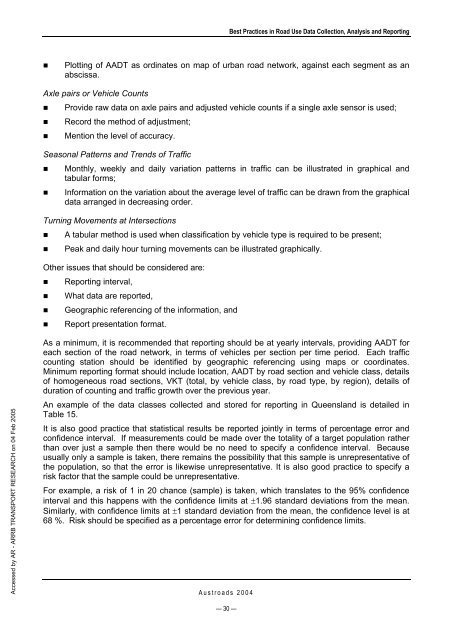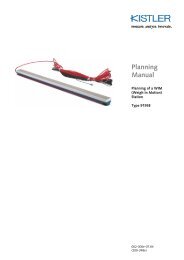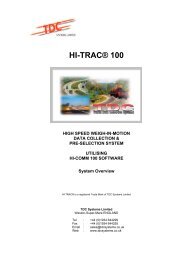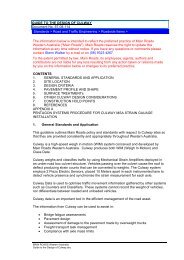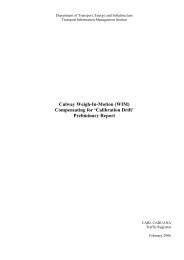AP-G84/04 Best practice in road use data collection, analysis ... - WIM
AP-G84/04 Best practice in road use data collection, analysis ... - WIM
AP-G84/04 Best practice in road use data collection, analysis ... - WIM
Create successful ePaper yourself
Turn your PDF publications into a flip-book with our unique Google optimized e-Paper software.
Accessed by AR - ARRB TRANSPORT RESEARCH on <strong>04</strong> Feb 2005<br />
Aust<strong>road</strong>s 20<strong>04</strong><br />
— 30 —<br />
<strong>Best</strong> Practices <strong>in</strong> Road Use Data Collection, Analysis and Report<strong>in</strong>g<br />
Plott<strong>in</strong>g of AADT as ord<strong>in</strong>ates on map of urban <strong>road</strong> network, aga<strong>in</strong>st each segment as an<br />
abscissa.<br />
Axle pairs or Vehicle Counts<br />
Provide raw <strong>data</strong> on axle pairs and adjusted vehicle counts if a s<strong>in</strong>gle axle sensor is <strong>use</strong>d;<br />
Record the method of adjustment;<br />
Mention the level of accuracy.<br />
Seasonal Patterns and Trends of Traffic<br />
Monthly, weekly and daily variation patterns <strong>in</strong> traffic can be illustrated <strong>in</strong> graphical and<br />
tabular forms;<br />
Information on the variation about the average level of traffic can be drawn from the graphical<br />
<strong>data</strong> arranged <strong>in</strong> decreas<strong>in</strong>g order.<br />
Turn<strong>in</strong>g Movements at Intersections<br />
A tabular method is <strong>use</strong>d when classification by vehicle type is required to be present;<br />
Peak and daily hour turn<strong>in</strong>g movements can be illustrated graphically.<br />
Other issues that should be considered are:<br />
Report<strong>in</strong>g <strong>in</strong>terval,<br />
What <strong>data</strong> are reported,<br />
Geographic referenc<strong>in</strong>g of the <strong>in</strong>formation, and<br />
Report presentation format.<br />
As a m<strong>in</strong>imum, it is recommended that report<strong>in</strong>g should be at yearly <strong>in</strong>tervals, provid<strong>in</strong>g AADT for<br />
each section of the <strong>road</strong> network, <strong>in</strong> terms of vehicles per section per time period. Each traffic<br />
count<strong>in</strong>g station should be identified by geographic referenc<strong>in</strong>g us<strong>in</strong>g maps or coord<strong>in</strong>ates.<br />
M<strong>in</strong>imum report<strong>in</strong>g format should <strong>in</strong>clude location, AADT by <strong>road</strong> section and vehicle class, details<br />
of homogeneous <strong>road</strong> sections, VKT (total, by vehicle class, by <strong>road</strong> type, by region), details of<br />
duration of count<strong>in</strong>g and traffic growth over the previous year.<br />
An example of the <strong>data</strong> classes collected and stored for report<strong>in</strong>g <strong>in</strong> Queensland is detailed <strong>in</strong><br />
Table 15.<br />
It is also good <strong>practice</strong> that statistical results be reported jo<strong>in</strong>tly <strong>in</strong> terms of percentage error and<br />
confidence <strong>in</strong>terval. If measurements could be made over the totality of a target population rather<br />
than over just a sample then there would be no need to specify a confidence <strong>in</strong>terval. Beca<strong>use</strong><br />
usually only a sample is taken, there rema<strong>in</strong>s the possibility that this sample is unrepresentative of<br />
the population, so that the error is likewise unrepresentative. It is also good <strong>practice</strong> to specify a<br />
risk factor that the sample could be unrepresentative.<br />
For example, a risk of 1 <strong>in</strong> 20 chance (sample) is taken, which translates to the 95% confidence<br />
<strong>in</strong>terval and this happens with the confidence limits at ±1.96 standard deviations from the mean.<br />
Similarly, with confidence limits at ±1 standard deviation from the mean, the confidence level is at<br />
68 %. Risk should be specified as a percentage error for determ<strong>in</strong><strong>in</strong>g confidence limits.


